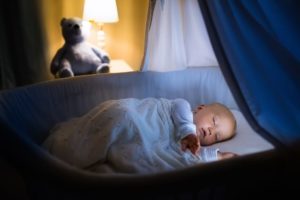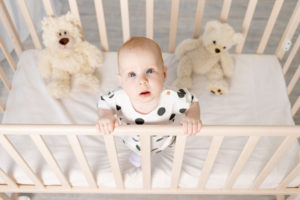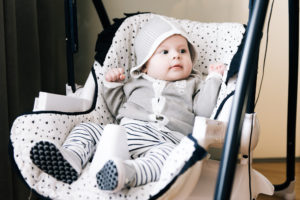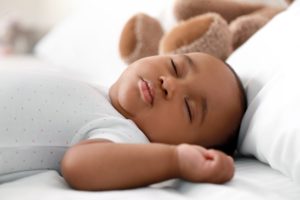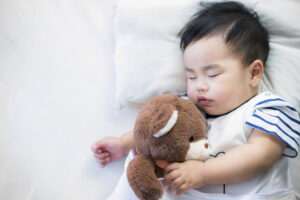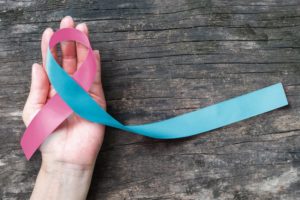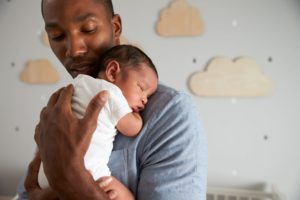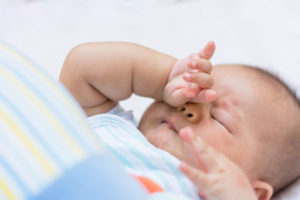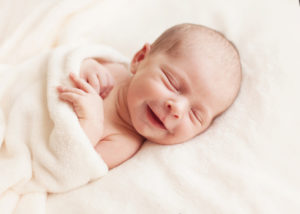How Your Baby’s Sleep Cycle Differs From Your Own
Baby sleep patterns can feel like a mystery to new parents, especially when they cause the parents sleep deprivation. In healthy adults, sleep patterns are fairly predictable and consistent. In comparison, an infant’s sleep cycle might seem random, with the baby waking up and falling asleep at any time of day or night.
By learning more about baby sleep cycles, parents can better understand their infant and potentially ease both frustration and worry. Sleep plays a major role in a baby’s cognitive development . Therefore, it is important for parents to understand and promote good sleep.
How Is an Infant’s Sleep Schedule Different From an Adult’s?
Infants and adults differ with how much and when they sleep. Generally, healthy adults sleep at least seven hours each night, in a single block of time that is largely uninterrupted . In comparison, newborn babies require up to 18 hours of sleep, broken into multiple short periods , every 24-hours. By six months, babies sleep an average of about 13 hours each day, over larger blocks of time .
Many parents understandably want their baby to sleep through the night. The longer a baby sleeps quietly, the longer the parents can sleep. Unfortunately, most parents of newborns must accept their baby waking up several times during the night. Newborn babies wake up throughout the night because they have not fully developed a strong circadian rhythm that makes children and adults tired at night instead of during the day.
Most babies begin to approximate a more “adult” sleep schedule between three months and one year of age. During this time of life, babies begin to sleep for longer periods during the night and shorter periods during the day time.
However, not all babies conform to an “adult” sleep schedule at the same age. Parents should not worry if their baby is not “sleeping through the night” prior to one year of age. Even after one year, it is common for many babies to wake up at least once per night.
What Does a Baby’s Sleep Cycle Look Like?
Generally, researchers identify two sleep stages in newborn babies and four sleep stages in babies over three months old. The newborn sleep stages are rapid eye movement (REM) and non-rapid eye movement (NREM). Newborns spend close to equal amounts of time in REM and NREM while they sleep .
The REM sleep stage is frequently called “active sleep” and NREM is called “quiet sleep.” During “active sleep,” or REM, a baby can be seen making small movements . The baby’s eyes move around (while closed), their limbs and fingers might twitch or jerk, their breathing might speed up, and they might move their mouths. During “quiet sleep,” or NREM, the baby is still and does not make these movements.
Once a baby reaches around three months of age, they begin experiencing the same sleep stages that adults experience. Adults experience four distinct sleep stages . These sleep stages include three stages of NREM sleep and one REM sleep stage. They are distinguished by the following brain waves:
- Stage 1 (NREM 1): alpha waves and low-amplitude mixed-frequency activity
- Stage 2 (NREM 2): sleep spindles and K-complexes
- Stage 3 (NREM 3): delta waves
- Stage 4 (REM): alpha and beta waves (similar to waking state)
The first three stages of sleep are all NREM stages. The first two are lighter stages of sleep, during which a person can be easily awakened. The third stage of sleep is the deepest stage, and it is very difficult to wake someone in this stage. The fourth stage of sleep is REM, the stage in which people experience dreams. Adults experience these stages in the order they are numbered.
Although babies begin experiencing four stages of sleep around three months, it is not until closer to 5-years-old that children’s “sleep architecture,” or their time spent in each sleep stage, begins to mirror that of adults . As babies, they experience a short REM stage almost immediately after falling asleep instead of last in the cycle . In contrast, adults do not experience REM until they have been asleep for around 90 minutes.
How Do Sleep Cycles Progress as a Baby Grows?
A newborn baby’s sleep cycle falls into the two categories of REM/active and NREM/quiet. In the first few months of life, babies’ sleep is split nearly evenly between REM and NREM sleep stages. As a baby grows, their sleep cycles progress and they begin to spend less time in REM sleep. They also begin experiencing the three stages of NREM, instead of one. As a baby grows, their sleep cycle looks more and more like an adults’ sleep cycle.
Understanding a baby’s sleep cycle is important for parents interested in sleep training. Because babies are not born with a strong circadian rhythm, sleep training is not possible for most newborns. Parents who want to sleep train have to work with their baby’s unique development timeline, and might not be able to sleep train until six months of age.
How Much REM Sleep Do Babies Get?
Newborn babies spend roughly 50% of their time asleep in REM. Since newborns sleep up to 18 hours each 24-hour period, that means they experience up to nine hours of REM each day.
As a baby’s sleep schedule changes, so do their sleep cycles. Baby REM sleep is one part of the sleep cycle that changes over time. However, there is no simple chart outlining sleep cycle length or REM by age.
As babies grow and sleep fewer hours, they spend less of their sleep time in the REM stage. By adulthood, people experience REM for roughly 20% of each night’s sleep, which is far less than the 50% of sleep newborns spend in REM.
References
9 Sources
-
Tham, E., Schneider, N., & Broekman, B. (2017). Infant sleep and its relation with cognition and growth: a narrative review. Nature and Science of Sleep, Volume 9, 135–149.
https://www.ncbi.nlm.nih.gov/pmc/articles/PMC5440010/ -
Watson, N. F., Badr, M. S., Belenky, G., Bliwise, D. L., Buxton, O. M., Buysse, D., Dinges, D. F., Gangwisch, J., Grandner, M. A., Kushida, C., Malhotra, R. K., Martin, J. L., Patel, S. R., Quan, S., & Tasali, E. (2015). Recommended amount of sleep for a healthy adult: A joint consensus statement of the American Academy of Sleep Medicine and Sleep Research Society. Sleep, 38(6), 843–844.
https://www.ncbi.nlm.nih.gov/pmc/articles/PMC4434546/ -
Wielek, T., Del Giudice, R., Lang, A., Wislowska, M., Ott, P., & Schabus, M. (2019). On the development of sleep states in the first weeks of life. PLoS One, 14(10), e0224521.
https://journals.plos.org/plosone/article?id=10.1371/journal.pone.0224521 -
Sadeh, A., Mindell, J. A., Luedtke, K., & Wiegand, B. (2009). Sleep and sleep ecology in the first 3 years: a web-based study. Journal of Sleep Research, 18(1), 60–73.
https://pubmed.ncbi.nlm.nih.gov/19021850/ -
Daftary, A. S., Jalou, H. E., Shively, L., Slaven, J. E., & Davis, S. D. (2019). Polysomnography reference values in healthy newborns. Journal of Clinical Sleep Medicine, 15(03), 437–443.
https://pubmed.ncbi.nlm.nih.gov/30853051/ -
Grigg-Damberger, M. M. (2016). The visual scoring of sleep in infants 0 to 2 months of age. Journal of Clinical Sleep Medicine, 12(03), 429–445
https://www.ncbi.nlm.nih.gov/pmc/articles/PMC4773630/ -
Patel, A. K., Reddy, V., & Araujo, J. F. (2020). Physiology, Sleep Stages. StatPearls Publishing.
https://www.ncbi.nlm.nih.gov/books/NBK526132/ -
Crosby, B., LeBourgeois, M. K., & Harsh, J. (2005). Racial differences in reported napping and nocturnal sleep in 2- to 8-year-old children. Pediatrics, 115(1), 225–232.
https://www.ncbi.nlm.nih.gov/pmc/articles/PMC2987587/ -
El Shakankiry, H. M. (2011). Sleep physiology and sleep disorders in childhood. Nature and Science of Sleep, 3, 101.
https://www.ncbi.nlm.nih.gov/pmc/articles/PMC3630965/




